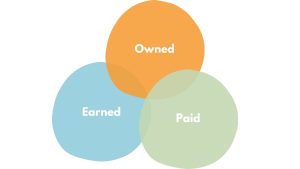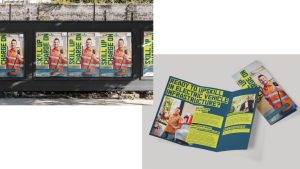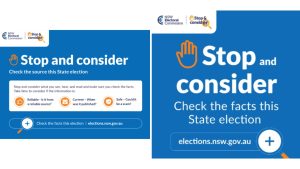Have you ever read a book only to reach the final chapter and feel utterly disappointed? Or left the cinema…
Read MoreThe 4-Step Guide to Smarter Campaign Distribution

Creating content is only half the job. The real challenge is making sure the right people see it, understand it, and take action.
For government teams, not-for-profits and public-facing organisations, it can be frustrating to see important campaigns buried in busy feeds.
When that happens, valuable messages miss their audience and opportunities for education, engagement and behaviour change are lost.
Off the back of a recent webinar with Punchy Digital Media’s Anthony Lam and Strategic Communications Advisor Rachel Abad, we have pulled together a simple four-step framework to help your content reach the people it is designed for.
Want to see the full webinar? Watch the recording here
Step 1: Understand Your Content’s Purpose
One of the most common mistakes is jumping into production without a clear reason why.
Before creating anything, you need to define the purpose of the campaign.
What behaviour are you trying to influence? What does success look like?
Content only works when it is grounded in a clear strategy. If the objectives are vague or if stakeholders are not aligned before briefing the creative team, the project risks confusion and missed expectations.
It is like building a house without a proper plan. You might get halfway through and realise there is nowhere to put the windows.
Before briefing a production team or consideration a distribution plan, make sure you can answer the following:
- What is our campaign trying to communicate?
- What action do we want the audience to take?
- Is the message more functional or emotional?
- Is this content part of a broader campaign or a standalone message?
- How long does the message need to stay relevant?
Clarity at this stage helps everyone get on the same page. It makes the process smoother and the final result more effective.
Need help getting started? Download our free briefing template. It lays out all the key questions you need to answer before you begin, so your project starts with a clear direction.
Step 2: Know the Who, What and How of Your Audience
Now let us talk about your audience.
If you joined the last webinar, you might remember the behaviour change model and the bubble analogy we used to understand audience mindset. Here is a quick recap.
Each of us lives in a personal bubble. It is shaped by what we do, what we believe, where we go, and how we think. These bubbles are built from our habits, influences, values and identity.

Now imagine millions of these bubbles floating around. Some might overlap slightly, like people visiting the same café or sharing a hobby, but each one is still entirely unique.
Understanding what exists inside someone’s bubble allows you to communicate in a way that truly resonates. You can connect to what they care about, what drives them, and what might be holding them back.
To do that, break it down into three key areas: Who, What and How.
Who are they?
- Where do they live?
- Where do they work?
- Are they internal staff or an external audience?
- Do they trust your organisation or sector?
- What life stage are they in? Are they a student, a new parent or a retiree?
What do they engage with?
- What platforms or channels do they use most?
- How do they typically discover new information?
- What is their existing engagement with you?
- Do they value word of mouth, community endorsement or peer reviews?
How do they experience your message?
- What literacy or accessibility needs should you consider?
- What might prevent them from engaging with your content? Time, access, or relevance?
- How does your message fit into their daily routine or behaviour?
Asking these questions can help reveal the behaviours, preferences and potential blockers that shape how your content is received or ignored.
Once you know who you are speaking to and how they navigate the world, you can start to create content that meets them where they are and speaks to what matters most.

How to Find the Answers
It is not uncommon to feel unsure when trying to answer detailed questions about an unfamiliar audience.
Guessing often leads to poor results, so it is important to take time to gather real insights.
Here are a few reliable ways to do that:
Focus Groups
Focus groups offer direct and valuable insights before developing any campaign strategy or creative assets. They can uncover behaviours, preferences and barriers that are not always visible from the outside.
In one recent Punchy campaign targeting young construction workers who vape, a focus group was conducted to test a new support option delivered through WhatsApp. The assumption was that the platform would appeal to the target audience. However, participants aged between eighteen and twenty five said they did not use WhatsApp at all and had no intention of doing so. One person even said, “If it was Snapchat, maybe I would use it.” This single insight shifted the direction of the campaign significantly.
Even small focus groups can reveal information that helps shape a stronger, more effective campaign.
Informal Conversations
If a formal focus group is not possible, informal conversations can also provide value. Speaking with someone from the target audience can help clarify assumptions and give practical direction.
If the campaign is aimed at young parents, first-year university students, older migrants or apprentices, consider speaking with someone who fits that profile. This might be a friend, a family member or a neighbour.
A short conversation over coffee can reveal more than hours of internal discussion.
Online Research and AI Tools
Desktop research is another useful method for gathering insight. This can include reviewing publicly available data or using artificial intelligence tools to explore trends and behaviours.
When using AI tools, it is important to ask focused questions and request credible sources such as government or industry reports. For example, instead of asking “What platforms do young people use,” a better question would be “What social media platforms are most used by construction workers aged eighteen to twenty five in Australia.”
Some other examples of effective prompts include:
- What government reports or studies are available on vaccine hesitancy in regional communities in Australia?
- What communication channels are most trusted by culturally and linguistically diverse communities for health messaging?
- What industry reports are available on public attitudes towards renewable energy projects in New South Wales?
- What behaviour change campaigns have been used to reduce littering in urban parks?
Always ask AI tools to provide sources, and double-check that these sources actually exist and are valid. AI can sometimes generate references that appear credible but are not real.
Artificial intelligence should be used to guide further research, not replace it. It is a helpful assistant for validating or challenging assumptions.
Step 3: Map Your Channels and Budget
Once your campaign purpose is clear and you understand your audience, it is time to plan how you will reach them.
Start by confirming the essentials:
- What is the total budget for distribution?
- Is there any additional funding or partner support?
- What channels do you already have? This could include your website, social media, email lists or internal networks.
- Are there delivery partners or stakeholders involved?
- What does success look like for this campaign?
With this information, you can map out a distribution plan.
A useful approach is to group channels into three categories: owned, earned and paid. This method allows you to clearly see what resources are available to you, where you may need support from others and where it makes sense to invest for additional reach.

Owned Channels
Owned channels are the platforms your organisation already controls. They are cost-effective, always available, and allow full control over content and timing.
Examples include:
- Your website: A central space to host updates, resources, videos and downloads.
- Email newsletters: A direct line to an engaged audience. Use them for updates, calls to action and campaign news.
- Social media accounts: Facebook, Instagram, LinkedIn, TikTok and YouTube are ideal for regular engagement and message reinforcement.
- SMS lists: Useful for urgent or time-sensitive updates that reach people directly.
- Internal communications: On-site posters, digital screens, campus radio and internal newsletters help spread messages within teams or facilities.
Owned channels are powerful because they are already trusted by your audience and have no added cost to use. They should always be the starting point for your distribution plan.
Best Practices
- Use each channel according to its strengths and match the format to the platform
- Write in plain English and use relevant keywords to improve search and accessibility
- Coordinate your rollout across multiple channels to build awareness
- Monitor what is working and adjust your approach as needed
Case Study: R U OK? Campaign
In the R U OK? campaign targeting multicultural seniors, a strong owned channel strategy led to high engagement. The campaign used in-language content, dedicated webpages and coordinated social posts to reach key audiences.

Simplified Chinese content generated the highest engagement, showing the impact of tailored and timely distribution through familiar platforms.
One standout lesson from the client’s key learnings was the importance of early community consultation. This should be built into briefs from the beginning to shape content that genuinely connects.
Earned Channels
Earned channels are spaces where others share your message without being paid to do so. This includes partners, communities, and media who amplify your work because it is relevant, timely and valuable.
Earned media is a powerful form of social proof. It builds trust, increases reach and enhances credibility.
Examples of Earned Channels
- Partner networks: Councils, government departments and advocacy groups often support relevant campaigns through their newsletters, websites or social media. This is often underused but highly effective.
- Community endorsements: Support from respected figures or groups, such as local leaders or on-the-ground advocates, is especially valuable for reaching multicultural or hard-to-reach communities.
- Forums and community groups: Organic sharing by trusted admins or members can lend credibility and increase relevance.
- Social media mentions: When others share or engage with your content online, it boosts visibility and reach through authentic engagement.
- Media coverage: Traditional press is another form of earned media. With the right pitch and message, campaigns can gain exposure through news articles, interviews or segments. This works best when the content has clear public interest or relevance.
Best Practices
- Build a list of potential partners who are willing to share your content.
- Provide ready-to-use assets such as images, social tiles and suggested copy to make sharing easy.
- Brief partners ahead of time so they can coordinate their posts with your launch.
- Tailor messaging to suit your partners’ tone and audience, not just your own.
- Track reach and engagement through these channels to measure additional impact.
Case Study: Centre For U
In a campaign for Centre For U, earned channels outperformed expectations. The campaign promoted Australia’s first accredited EV charging course and targeted electricians and apprentices.
Awareness of the program was initially low, so the team activated a network of trusted partners, including NECA, Holmesglen TAFE and the ETU. These organisations shared content through newsletters, social media and even posters across campus locations.
Because the target audience already trusted these institutions, the campaign reached them quickly and effectively. The result was more than four times the expected number of enquiries, even before any paid advertising began.
This case shows that when the right partners are engaged, earned channels can outperform even paid media.

Paid Channels
Paid channels are any platforms where you pay to place your message in front of a specific audience. They offer precision, control and scalability.
While they often require more budget, they also allow for targeted reach and consistent visibility.
Examples of Paid Channels
- Social media ads: Targeted campaigns across Meta platforms such as Facebook and Instagram.
- Google Search and Display Ads: Appear when users search for relevant terms or visit related websites.
- Outdoor advertising: Billboards, bus shelters, transit placements and digital signage in public spaces.
- Print and radio advertising: Traditional media used to reach specific regional or demographic groups.
- Sponsored content: Paid articles or segments that appear in trusted publications.
- Influencer marketing: Paid endorsements through individuals with influence over your target audience.
Best Practices
- Start small and test different formats and placements before scaling.
- Use audience insights to guide where and how to invest.
- Craft clear, action-focused messages tailored to each platform.
- Target by location, language, interest or behaviour to reach specific groups.
- Monitor performance closely and adjust based on what is working.
Paid channels are most effective when used strategically. You do not need a large budget to get results. Precision, testing and optimisation are more valuable than size alone.
Case Study: NSW Electoral Commission
In the “Stop and Consider” campaign, paid media was used to raise awareness around election misinformation and reinforce the independence of the Commission.

Rather than creating new assets, the team repurposed creative developed in the previous year, updating only the dates. Paid placements were targeted by geography, age and voter eligibility, and included both digital and print channels.
This approach shows how effective paid media can be when the message is clear and the strategy is thoughtful. Reusing content saved time and budget, while still delivering strong impact across the state.
A big budget does not guarantee big results. Effective distribution comes from being highly focused and choosing channels that give your content the best chance of reaching the right people. Even with modest budgets, targeted placements in the right environments can deliver strong traction.
Step 4: Create a Rollout Plan with Purpose
The final step is to bring it all together with a clear and purposeful rollout plan.
This is not just about ticking boxes.
It is about making intentional decisions that connect each part of your campaign to your overall goal. That means briefing partners early, aligning your timing with audience readiness, using data to guide next steps and ensuring every asset supports your core message.
Key Principles for a Strategic Rollout
- Launch with alignment: Time your release across multiple channels to maximise visibility. A coordinated start helps your message land stronger.
- Lead with owned channels: Your website, emails and social pages are the most direct and cost-effective way to reach your audience. Make sure the primary landing page or destination is live before anything else goes out. If posters or ads link to a page that is not ready, valuable budget is lost.
- Reinforce the message: Do not be afraid to remind, reframe or reshare. Repetition helps messages stick, especially when delivered in different formats and contexts.
- Repurpose content: Turn a media release into social tiles, convert a fact sheet into a short video or adapt a campaign story into a newsletter update. Meet people where they are.
- Build a clear timeline: Map out when each asset goes live across each channel. This ensures coordination across internal teams, partners and media. It keeps everyone aligned and avoids confusion.
A strategic rollout is not about doing more. It is about doing what matters, in the right order, and reaching the right people in the right way.
When done well, it transforms a launch into a campaign that delivers real impact.
Example Rollout Plan
Let us walk through a high-level rollout plan and the thinking behind its sequencing.
This example outlines a four-week campaign rollout using owned, earned and paid channels. However, it is important to note that campaign preparation should begin well before Week One.
Pre-Launch Planning
Allow at least four weeks of preparation before the campaign goes live. This phase should include:
- Briefing key partners
- Developing creative assets
- Translating materials for multicultural audiences
- Securing internal approvals
- Booking media placements
- Confirming internal and external timelines
This groundwork ensures the rollout can happen smoothly and with full coordination across all teams and channels.

Week One: Launch Owned Channels
Begin with the channels you control. Launch the campaign across your website, email newsletters and organic social media. These channels should go live first to establish consistency in messaging and serve as the foundation for all other activity.
Week Two: Activate Earned Channels
Once your message is live on owned platforms, build momentum by activating earned channels. This includes partner newsletters, community posts and organic sharing. Early media outreach should also begin during this stage to coincide with rising awareness.
Week Three: Scale with Paid Media
As your message gains traction, introduce paid media. Start with print placements, followed by radio, outdoor and paid digital ads. Because the audience has already seen the message, paid placements reinforce rather than introduce it, making them more effective.
Week Four: Maintain Visibility
In the final week, continue using both paid and organic content to reinforce key messages. Share reminders, repurpose high-performing assets and reach new audiences with adapted content formats. This sustained activity helps build recall and drive action.
A successful rollout is about rhythm and reinforcement. Each channel plays a role at the right moment. The aim is not a single launch event but a sequence of purposeful actions that build reach and engagement over time.
When planned well, the rollout becomes more than just a delivery schedule. It becomes a strategy that ensures your message connects with the right people in the right way.
Bringing It All Together
Every effective campaign begins with purpose. Start by defining what you want to achieve, who you are speaking to and how success will be measured.
Next, take time to understand your audience. Ask the right questions to uncover what they care about, where they get their information and what shapes their behaviour.
Use these insights to guide your channel choices. Do not rely on what is most familiar or convenient. Focus on what is most likely to connect with your audience.
Then build a rollout plan that is strategic. Coordinate your efforts across owned, earned and paid channels, and time your activity to build momentum rather than relying on a single launch moment.
This approach is not about doing more. It is about being thoughtful and deliberate in how you deliver your message, so it reaches the right people in the right way.
Final Thoughts
At the end of the day, even the best content will fall flat if it is not seen by the right people. That is why a clear distribution strategy matters just as much as the creative itself.
The good news is that effective distribution does not always require a huge budget. With a focused, strategic plan, you can maximise reach, build engagement and create real outcomes.
If you need support building a smarter rollout plan, Punchy now offers Strategic Communication Services, including Distribution Strategies. We help you identify the right channel mix, tap into partner networks, plan sequencing and formats, and align your content with broader campaigns. We also provide guidance on how to repurpose your video content across multiple platforms, making sure every asset works harder for you.
If you would like to explore how this could apply to your next campaign, get in touch.


